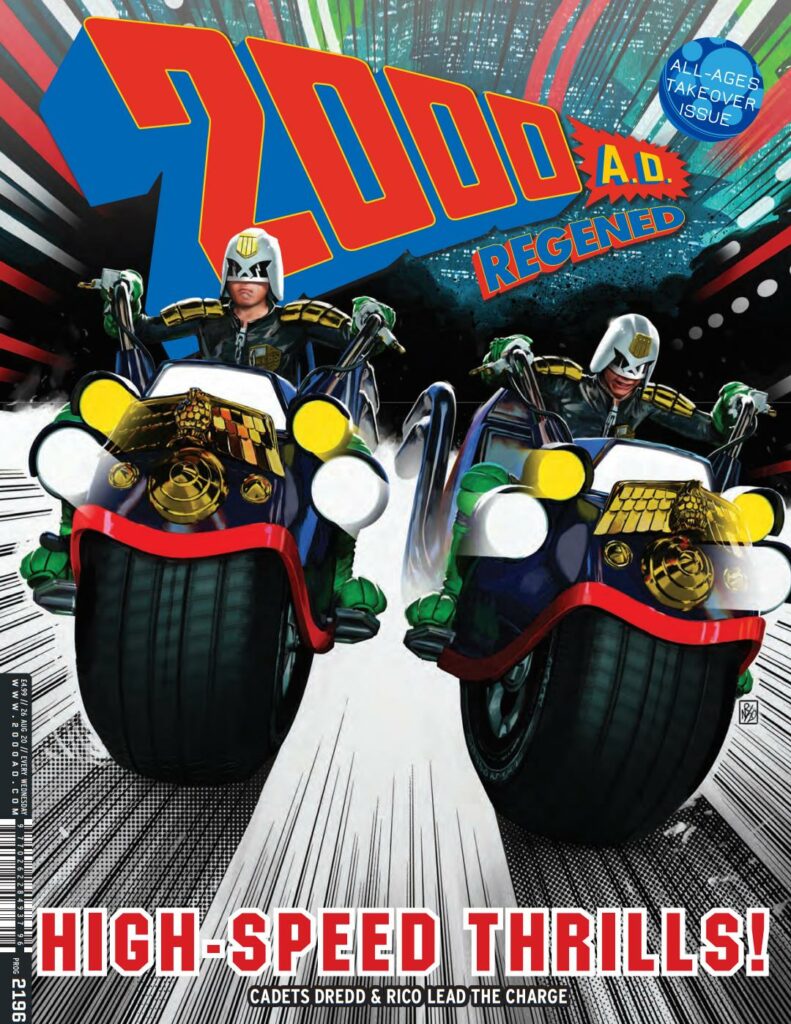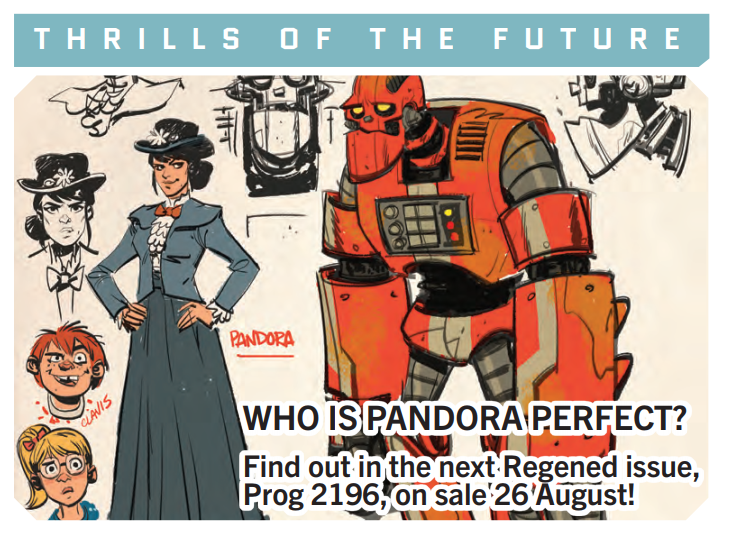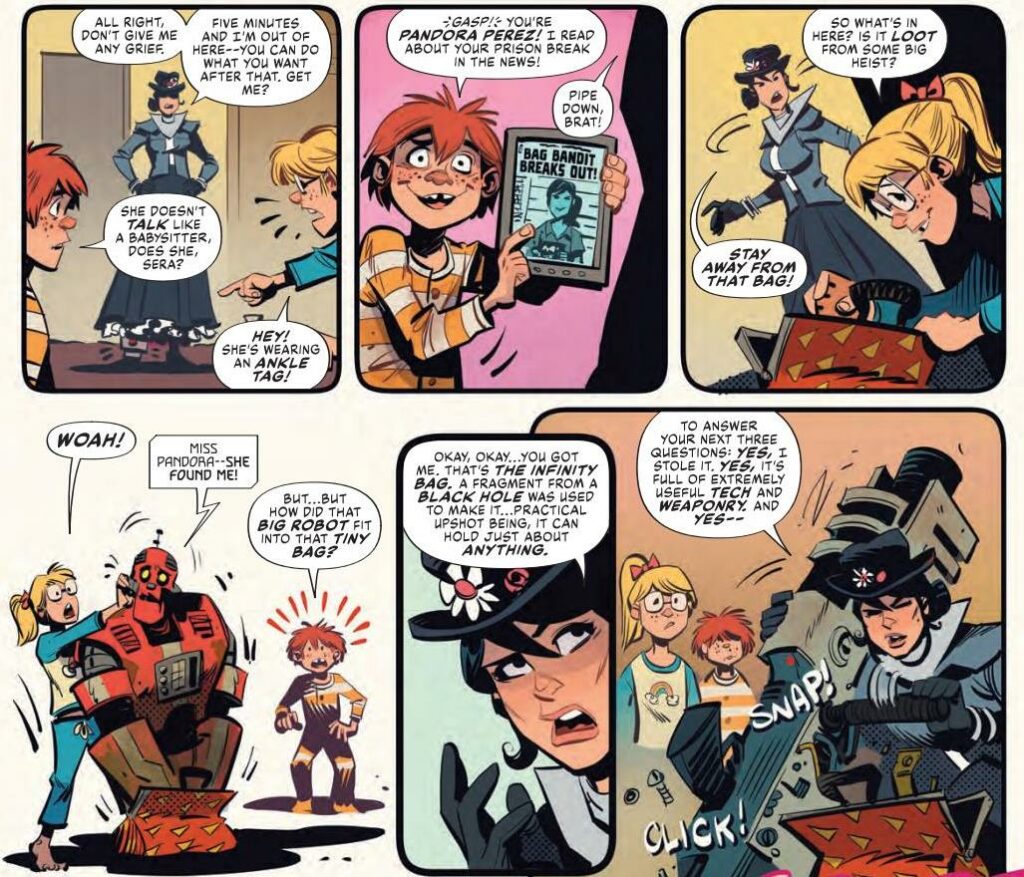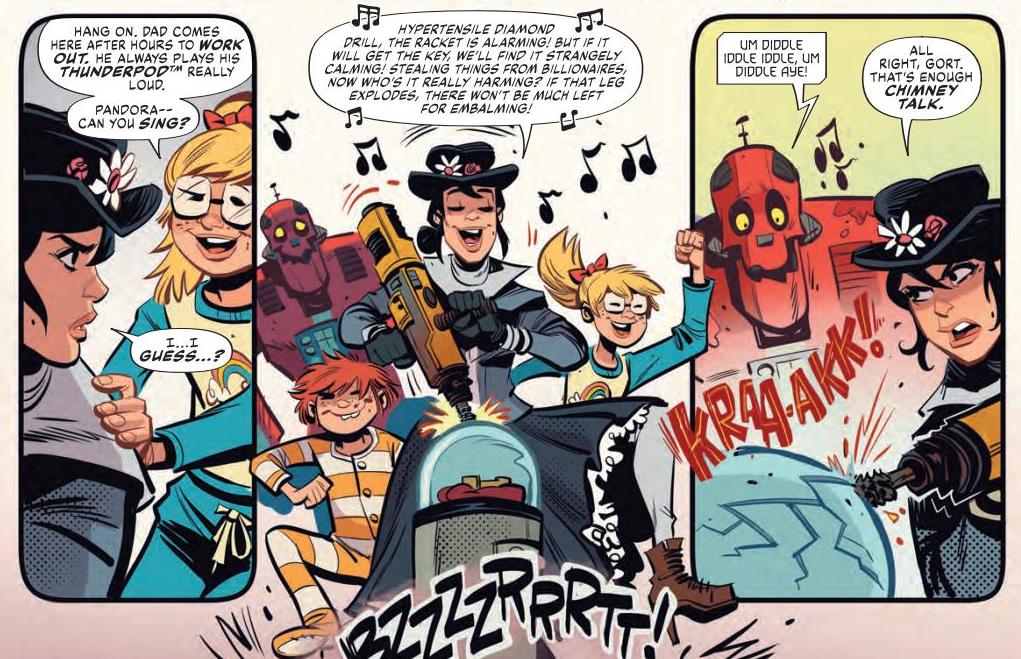Positively Pandora Perfect In Every Way – Talking Regened With Roger Langridge
29th August 2020
Are you ready to get Regened again? Oh yes, it’s time to bask in the all-ages thrills once more in 2000 AD Prog 2196, with the return of old favourites and the Zarjaz debut of two all-new strips!
Inside, you’ll find Cadet Dredd, more supernatural chills in Finder & Keeper, a brand-new Future Shock, and a new twist on Mega-City One’s Tek Judges in Department K. But right now, we’re going to chat to Roger Langridge about writing the brand-new strip, Pandora Perfect, with art from Brett Parson.
2000 AD Regened Prog 2196 is out now – grab it from the 2000 AD store!

In the Regened Prog 2196, you have a new strip, Pandora Perfect. And all I know of it is the promo ‘Thrills of the Future’ image that ran a little while back!
So given that – I’m going for the obvious Mary Poppins meets ABC Warriors sort of vibe.

Okay then, who is Pandora Perfect and just what can we expect from the strip?
Roger Langridge: Pandora Perfect is pretty much what you guessed – a sort of Mary Poppins Gone Wrong, a con-artist with a bag of tricks.
I’m not sure what made it pop into my head, but I liked the idea for younger readers of taking an archetype they might already be familiar with and subverting it, Harvey Kurtzman-style. I thought that kind of attitude was very much in keeping with the 2000 AD ethos as I understand it.
I gave her a robot sidekick to bounce off of, because it’s more interesting to see two characters interacting than one talking to herself the whole time… and we were off to the races!

Roger, you’re hardly what could be called a regular visitor to these 2000 AD parts. Correct me if I’m wrong, I usually am, but we first saw you in the pages with The Straitjacket Fits from ’91-’92 with David Bishop. Then there was the rather delayed Time Flies sequel, Tempus Fugitive, with Garth Ennis back in 1996. And finally, we have Whatever Happened to Cookie in 2004 with Si Spurrier. And in the middle of all that, we had you working on the first all-ages-ish 2000 AD publication, Judge Dredd Lawman of the Future back in 1996.
RL: That is pretty much my 2000AD career in a nutshell! Like a comet that passes every 90 years…
I think it’s fair to say that you’re an writer & artist who’s not exactly unfamiliar with making a huge variety of work, including plenty of all-ages material.
So, does this feel something of a natural fit for you with doing an all-ages strip for 2000 AD?
RL: Well, I’m assuming my experience working in the all-ages arena was why I was approached in the first place. I’d written something else for Tharg recently that hasn’t come out yet, so those lines of communication were open in a way they hadn’t been for a while, and no doubt The Mighty One, in his infinite wisdom, saw an asset that could be put to further use.
As a reader I’ve been dipping in and out of 2000 AD since around Prog 240 or thereabouts, so I have some idea of the magazine’s voice. It’s always a thrill to be asked to be a part of it.

Going back to Pandora Perfect – so far in Regened we’ve seen multiple approaches to strips with established characters and new strips, including Finder & Keeper by Moore, Reppion, and Tinto (which has its fourth outing in this latest Regened), and then there’s Full Tilt Boogie, by Alec de Campi and Eduardo Ocana, which debuted in 2019’s Regened Prog 2130 and then moved to 2000 AD with its recently concluded first series.
So, I suppose when you debut a strip such as Pandora Perfect I’m sure the primary goal is to make a great strip for the one-off. But is there also an element of planning for the future?
In which case, how much work has gone into the development of the series and the inevitable world-building that comes in?
RL: I was asked to write it like it could be a pilot for a possible series, something stand-alone that could nonetheless work as an introduction to something bigger.
In our first story we get the basic information that she’s in disguise and on the run, so that opens up various questions: Who from? Why? Does she have plans further ahead than not getting caught right now? How did she and G.O.R.T. become partners in crime? I freely confess I haven’t worked out a whole lot of this in advance. At the moment it’s more about planting seeds that might turn into something later on. If there’s demand for further stories, working out all this stuff will be half the fun.
Although, having said that, a part of me likes the immediacy and seat-of-the-pants nature of this first instalment. It’s possible that these characters work better without a bigger picture… or, if there is one, one they’re not aware of. I honestly don’t know, and that open canvas is something I find very appealing.

A quick mention of Brett Parson on art duties – did you write Pandora knowing that he’d be on art duties?
RL: I wrote this story not knowing who would be drawing it, but if we do anything more I’d like to get him involved at the concept level, assuming he’d be up for that. He nailed what was in my head to a T.
I would love to do more Pandora Perfect stories and I was beyond delighted that Brett was up for drawing it. I’ve loved his style for a while now, and tonally it’s exactly what I’d imagined for the strip. Right now I’m up to my eyeballs in drawing Bill and Ted comics, but when the dust settles a bit I’m very up for doing some more with the characters, especially if Brett’s on board.
As far as Regened is concerned – we’ve seen it go from that initial FCBD Prog, to the once a year Prog, and now we’re getting quarterly Regened. So, what do you think about Regened as a whole?
RL: It’s smart. It’s a smart thing to do. It’s been accepted wisdom that the readership of genre comics was getting older for a while now, and the up-and-coming generation were either ignoring comics entirely, or only reading YA graphic novels and Manga. So giving younger readers a regular gateway seems like sound business sense, quite apart from the artistic sense of asking creators to work within specific parameters – accepting a set of constraints often leads to interesting work. So even if it didn’t achieve its goal of enticing younger readers – and I have no reason to believe it’s not doing that – I think it would still be worth doing for getting a different perspective and some fresh ideas into the comic.

And where would you like to see Regened going in the future?
RL: Ideally, I’d like to see it spun off as a companion magazine! To Tharg’s credit, the range of styles is already pretty broad, but personally I’d like to see it broadened even further, having some out-and-out bigfoot humour in there. I do like the bit of Graphic Novel Cred they had from having Rob Davis in there recently – if that’s what the current generation are reading, bring more of those creators in and see who follows them. I’d love to see a Jamie Smart strip in there. Give it its own identity.
Yes! Jamie Smart would be so good! Readers, If you haven’t already, go hunt down Jamie’s work!
Okay then, what about the classic 2000 AD characters that you’d love to see in a Regened Prog?
RL: I was a huge, huge fan of Robo-Hunter back in the black-and-white days, during Ian Gibson’s tenure. It was like 2000 AD’s answer to Jack Cole’s Plastic Man, in that Sam Slade was the only sane person in a world full of lunatics. I miss that world a lot, and I think it would be a fantastic fit for Regened.

And with the whole concept of Regened being all about getting younger readers into comics and into 2000 AD… how did you first come to read comics? What was the thing that really made you think, ‘Wow, I love this…’?
RL: My first comic-reading experiences were actually before I could read, when my mum would buy me Disney comics. I was drawn to the work of Carl Barks very early on – this was before they put his name on the comics, but I recognised his style. Or, really, his styles, plural, because those early 1970s comics contained reprints of older stories from throughout his career. The 1940s and ‘50s stories were by “my favourite artist” and the ‘60s ones were by “my second-favourite artist”. I didn’t realise they were both by the same (brilliant) guy until much later.
And if that wasn’t 2000 AD, when did you first experience the Prog?
RL: I got into 2000 AD when I was maybe 13 years old? It was something I was vaguely aware of before then but I didn’t pick it up for whatever reason. I think I started taking it seriously when I became aware that many writers and artists I really liked, who were starting to work in American comics by the early ‘80s, got their start in 2000 AD and I thought, “must investigate”. I think what really hooked me was the sheer range of styles all in close proximity to one another. It was an embarrassment of riches. Any single issue could have work by Dave Gibbons, Brian Bolland, Alan Davis, Mick McMahon, Kev O’Neill, Ian Gibson, Cam Kennedy, Brendan McCarthy (takes breath) – usually several of those names in the same issue – and this came out every week?! I was very much of the opinion that the whole was greater than the sum of its parts. Still am, really. The astonishing variety was its Secret Ingredient.
With Regened, we’re seeing 2000 AD reaching out to younger readers, something that’s exploded in the past however many years with the likes of Dav Pilkey and Raina Telgemeier absolutely dominating things in terms of sales and completely changing the market from what we grew up with.
RL: I can’t see it as a bad thing that they like different stuff to what we liked at their age, really. I think it’s probably healthy. Like music, their taste should be something our generation don’t quite get; it shouldn’t necessarily be for us. 2000 AD was like that to our generation – my parents thought it was pretty out there, like a comic book version of punk rock. And that in itself evoked the scrappy, excessive comics of the 1940s – the pendulum swings back and forth, back and forth. ‘Twas ever thus.

What are your thoughts on bringing new readers into comics in general and 2000 AD in particular?
RL: I feel like maybe we’re not doing enough to go to where the readers are – which, increasingly these days, is on their phones. I don’t know quite how that would work – I’m an old fart, it wouldn’t be me who did it – but it seems to me that, a generation ago, some genius had the idea of turning Judge Dredd into a newspaper strip, thereby ensuring that everyone in the country had heard of the character.
A daily phone-formatted strip, maybe? Contained in an app, by someone who knows how to make effective web strips that can go viral occasionally? I don’t know. I think the world won’t cling to paper magazines forever, and the pandemic has only accelerated that general direction of travel. This is surely a problem for smarter heads than mine to solve, but it needs to be faced, I think.
Finally, Regened is all about getting new readers on board for 2000 AD, but it’s also part of the bigger picture of getting kids into comics. How do you see things progressing in the (hopefully) post-Covid world?
RL: If you’d asked me this sort of question (without the Covid!) 12 months ago, I’d have been quite gung-ho about it – they’ve got their own comics now, it’s a better time with more available than it’s ever been, and so on. Right now, though – and I’m writing this on a day when DC laid off 600 employees – I’m just concerned that comics survive at all.
Since the pandemic, things have been tough for publishers and creators alike. There will always be comics being created and there will always be readers who want them, but I can see the industry side of things – as opposed to the vast network of people doing comics primarily for the love of it – becoming much more difficult. So I suppose, to answer your question, I’d like to see some institutional support for kids’ comics from some of the huge corporations that dominate the market, as right now that seems like something we can’t take for granted. So, you know, bless Tharg for taking a punt.

